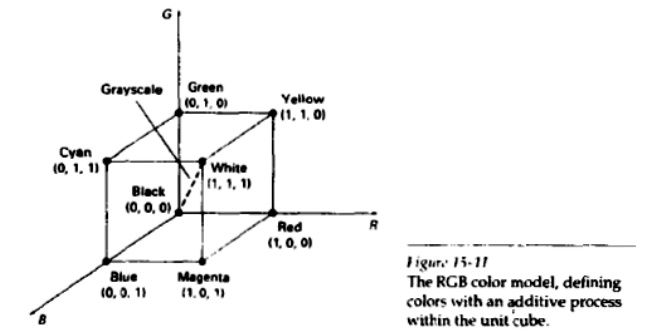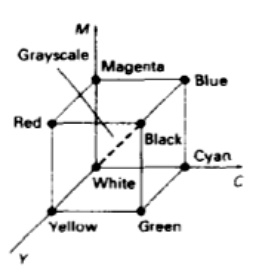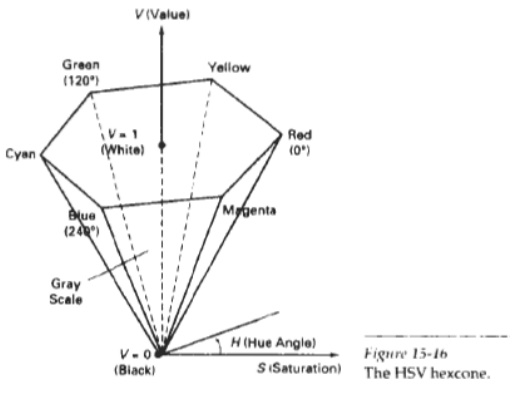Chapter: Graphics and Multimedia : Three-Dimensional Concepts
Color models
Color models
1. RGB COLOR MODEL
Based on the tri stimulus
theory of vision, our eyes perceive color through the stimulationof three
visual pigments in the cones of the retina. These visual pigments have a peak
sensitivity at wavelengths of about 630 run (red), 530 nm (green), and 450 nm
(blue).
By comparing intensities in a
light source, we perceive the color of the light. This theory of vision is the
basis for displaying color output on a video monitor using the three color
primaries, red, green, and blue, referred to as the RGB color model.
We can represent this model
with the unit cube defined on R,G, and B axes,
as shown in Fig. 15-11. The
origin represents black, and the vertex with coordinates(1; 1,l) is white.
Vertices of the cube on the axes represent the primary colors,and the remaining
vertices represent the complementary color for each of the primary colors.
As with the XYZ color system,
the RGB color scheme is an additive model.
Intensities of the primary
colors are added to produce other colors. Each color point within the bounds of
the cube can be represented as the triple (R, G, B), where values for R, G, and
B are assigned in the range from 0 to 1. Thus, a color C, is expressed in RGB
components as

The magenta vertex is
obtained by adding red and blue to produce the triple (1,0,l). and white at
(1,l. 1) is thesum of the red, green, and blue vertices. Shadesof gray are
represented along the main diagonal of the cube from the origin(black) to the
white vertex.
Each point along this
diagonal has an equal contributionfrom each primary color, so that a gray shade
halfway between black and white is represented as (0.5, 0.5, 0.5).

2. YIQ COLOR MODEL
. The National Television
System Committee (NTSC) color model for forming the composite video signal is
the YIQ model, which is based on concepts in the CIE XYZ model.
In the YI Q color model,
parameter Y is the same as in the XYZ model. Luminance (brightness) information
is contained in the Y parameter, while chromaticity information (hue and
purity) is incorporated into the 1 and Q parameters.
A combination of red, green,
and blue intensities is chosen for the Y parameter to yield the standard luminosity
curve. Since Y contains the luminance information, black-and-white television
monitors use only the Y signal.
The largest bandwidth in the
NTSC video signal (about 4 MHz) is assigned to the Y information. Parameter I
contains orange-cyan hue information that provides the flesh-tone shading, and
occupies a bandwidth of approximately 1.5 MHz. Parameter Q carries
green-magenta hue information in a bandwidth of about 0.6 MHz.
An RGB signal can be
converted to a television signal using an NTSC encoder, which converts RGB
values to YIQ values, then modulates and superimposes the I and Q information
on the Y signal. The conversion from RGB values to YIQ values is accomplished
with the transformation

This transformation is based
on the NTSC standard RGB phosphor, whose chromaticity coordinates were given in
the preceding section. The larger proportions of red and green assigned to
parameter Y indicate the relative importance of these hues in determining
brightness, compared to blue.
An NTSC video signal can be
converted to an RGB signaul sing an NTSC decoder, which separates the video
signal into the YlQ components,'then converts to RGB values. We convert from
YIQ space to RGB space with the inverse matrix transformation from Eq. 15-6:

3.
CMY COLOR MODEL
1 A color model defined with
the primary colors cyan, magenta, and yellow (CMY) is useful for describing
color output to hard-copy devices.
Unlike video monitors, which
produce a color pattern by combining light from the screen phosphors, hard-copy
devices such as plotters produce a color picture by coating a paper with color
pigments. We see the colors by reflected light, a subtractive process.

In the CMY model, point (1,
1, 1) represents black, because all components of the incident light are
subtracted. The origin represents white light.
Equal amounts of each of the
primary colors produce grays, along the main diagonal of the cube. A
combination of cyan and magenta ink produces blue light, becausethe red and
green components of the incident light are absorbed. Other color combinations
are obtained by a similar subtractive process
We can express the conversion
from an RGB representation to a CMY representation with the matrix
transformation

where the white is
represented in the RGB system iis the unit column vector. Similarly,we convert
from a CMY color representation to an RGB representationwith the matrix
transformation where black is represented In the CMY system as the unit column
vector.

4. HSV COLOR MODEL
lnstead of a set of color
primaries, the HSV model uses color descriptions that have a more intuitive
appeal to a user. To give a color specification, a user selects a spectral
color and the amounts of white and black that are to be added to ohtain
differens shades, tints, and tones. Color parameters in this model are hue ( H
) , saturation(S) and value(V)
The three dimensional
representation of the HSV model is derived from the RGB cube. If we imagine
viewing the cube along the diagonal from the white vertex to the origin(black),
we see an outline of the cube that has the hexagon shape shown in fig. The
boundary of the hexagon represents the various hues, and it is used as the top
of the HSV hexcone. In the hexcone, saturation is measured along a horizontal;
axis and value is along a vertical axis through the center of the hexcone.
Hue is represented as an
angle about the vertical axis ranging from 0 degree at red through 360 degrees.
Vertices of the hexagon are separated by 600 intervals. Yellow is at 600, green at 1200 and cyan opposite e red at H
= 1800 complementary colors are 1800 apart

Saturation S varies from 0 to
1. It is represented in this model as the ratio of the purity of a selected hue
to its maximum purity at S = 1. A selected hue is said to be one-quarter pure
at the value S = 0.25. At S = 0, we have the gray scale.
Value V varies from 0 at the
apex of the hexcone to I at the top. The apex represents black. At the top of
the hexcone, colors have their maximum intensity. When V = 1 and S = 1, we have
the "pure" hues. White is the point at V = 1 andS =o
Related Topics